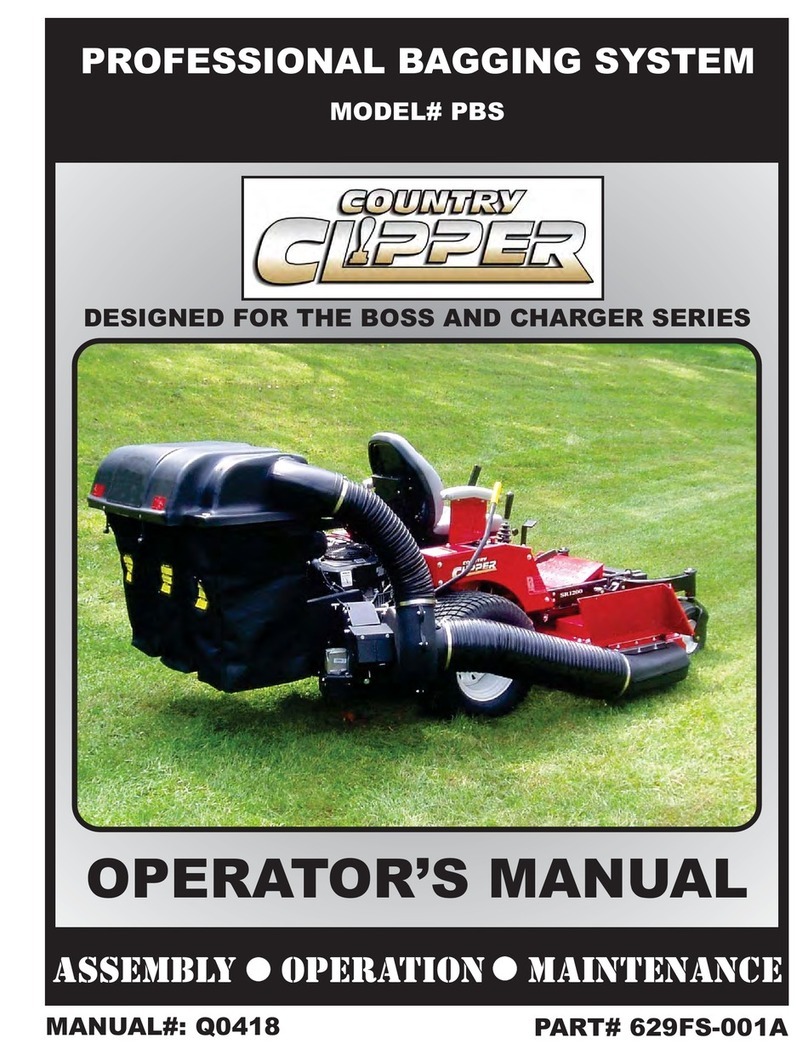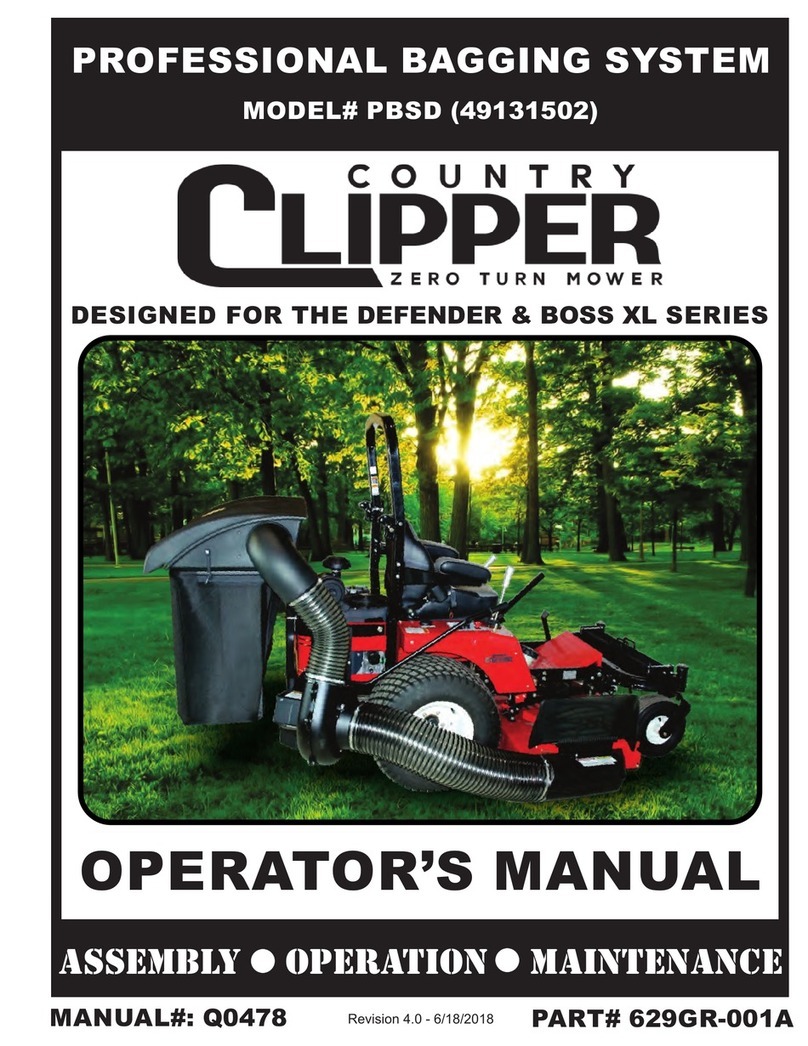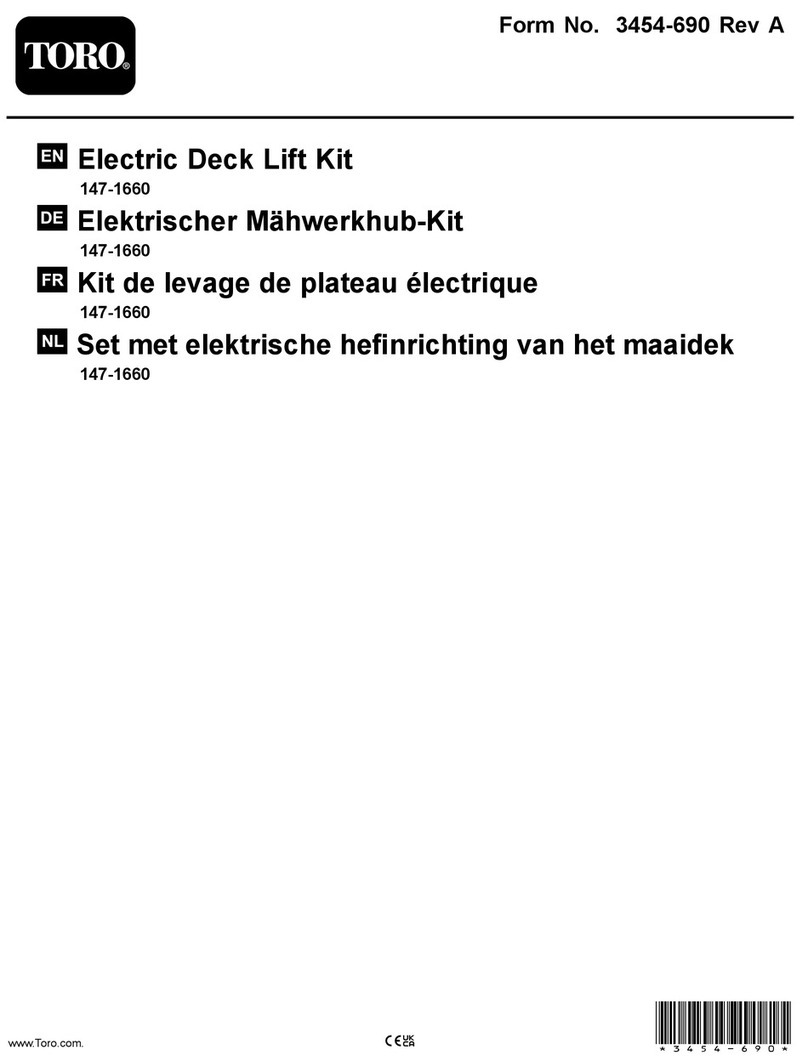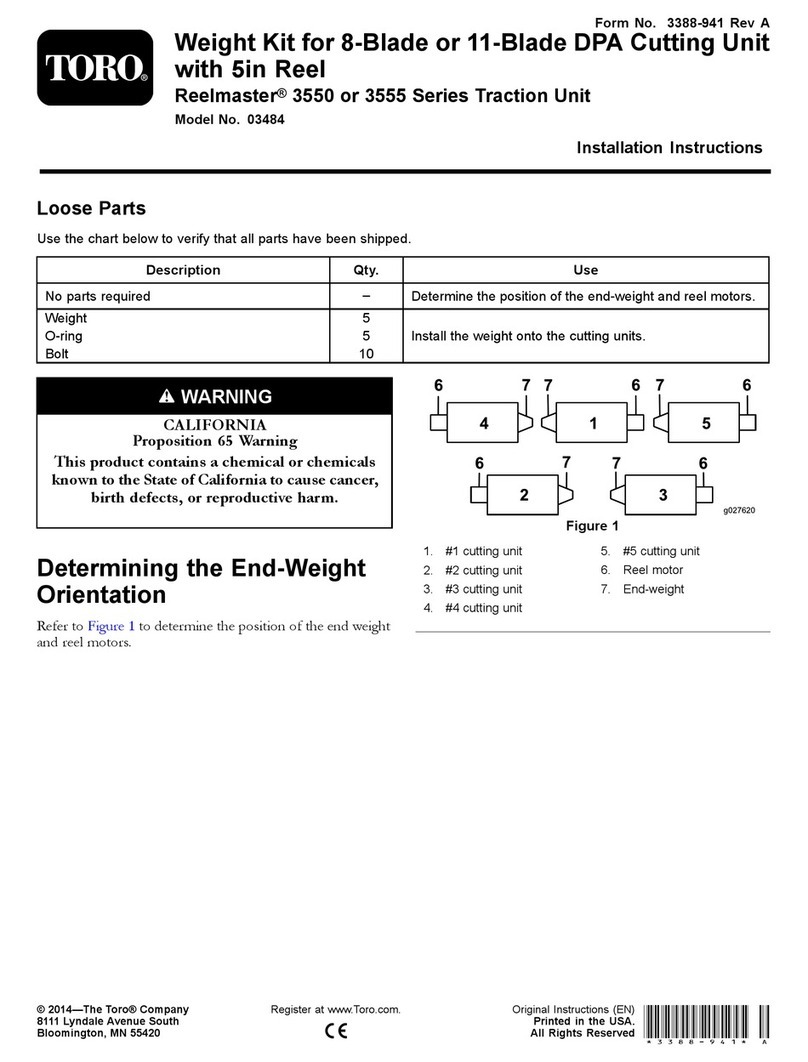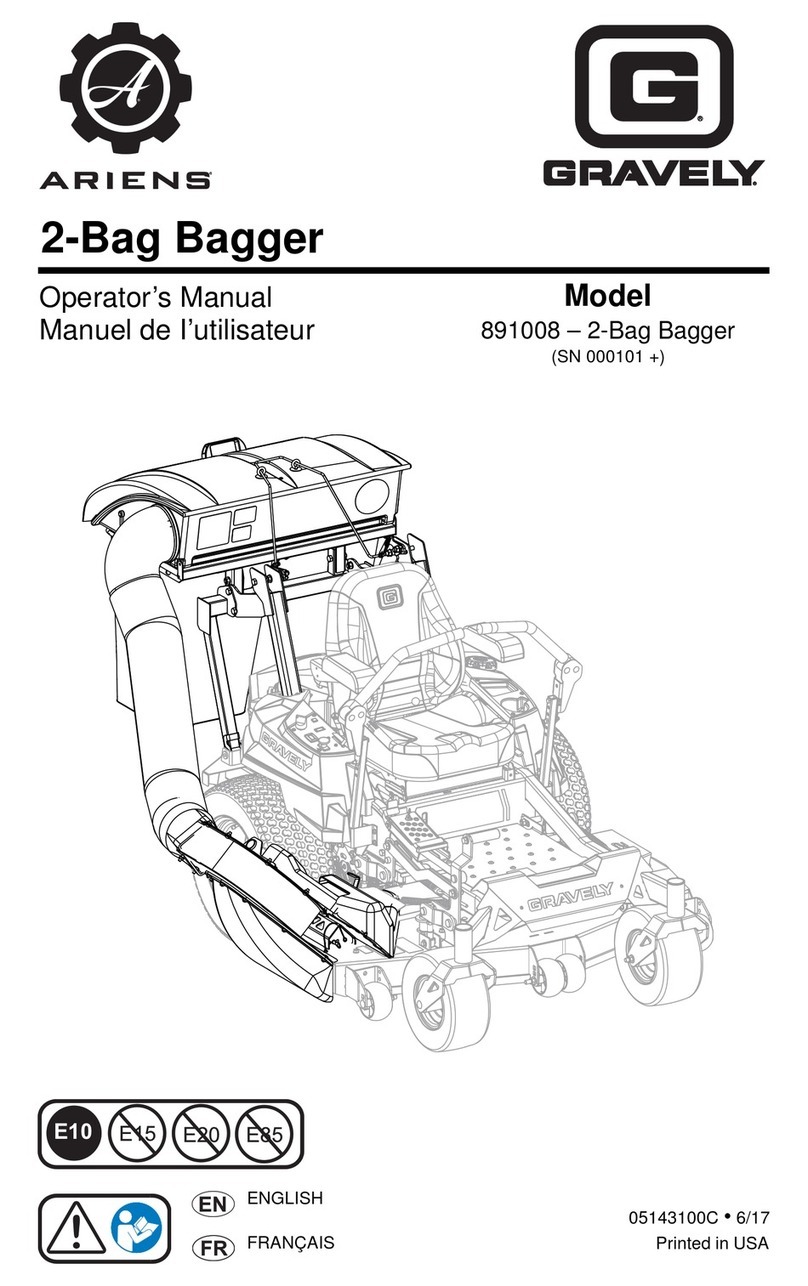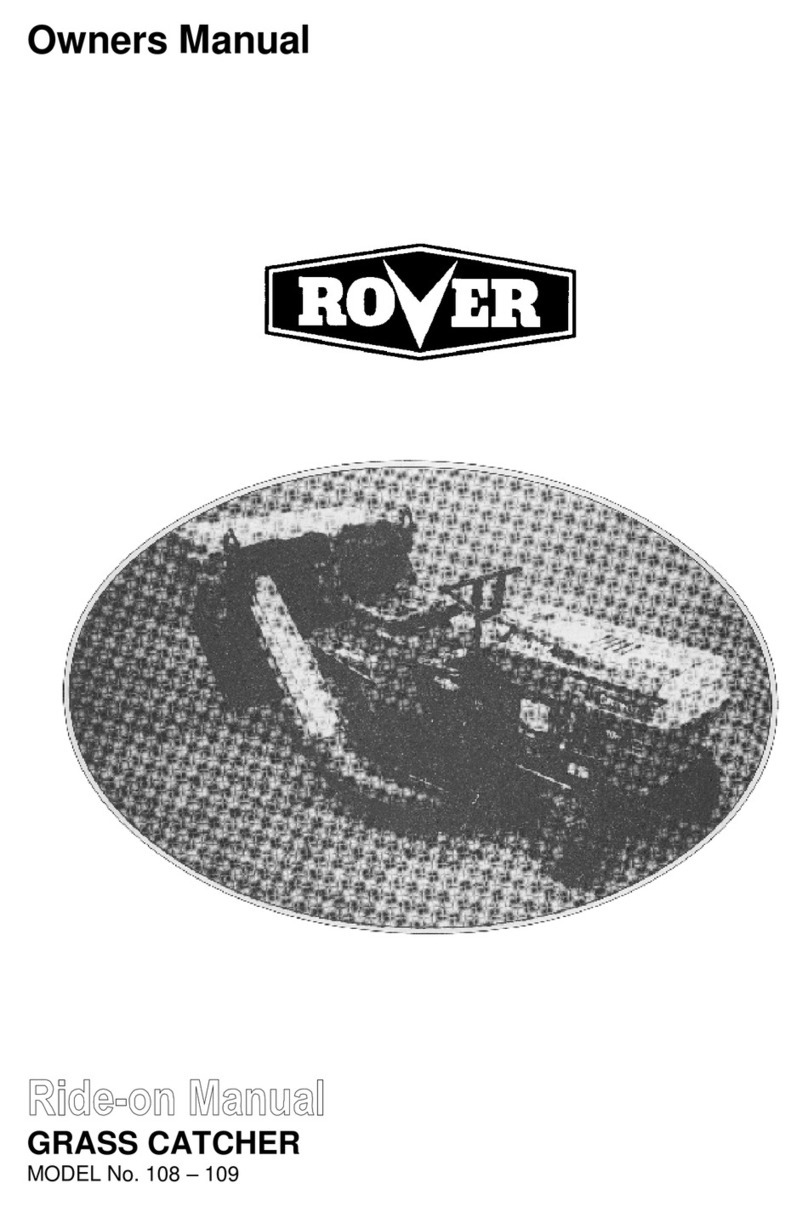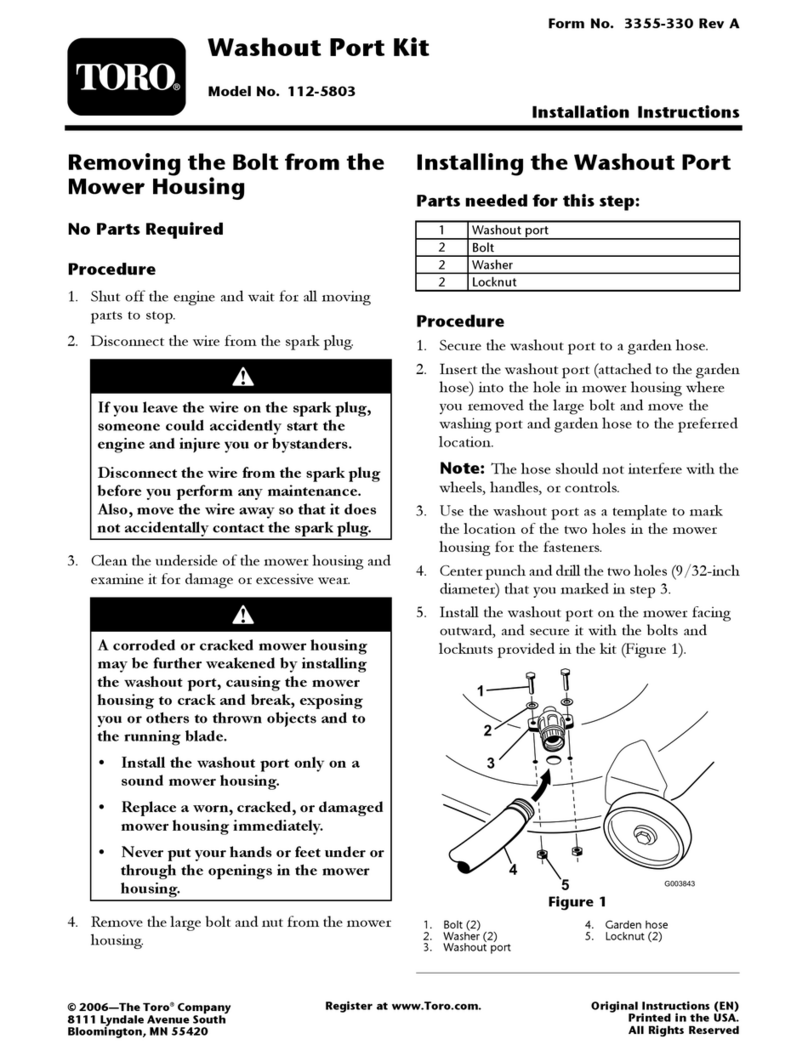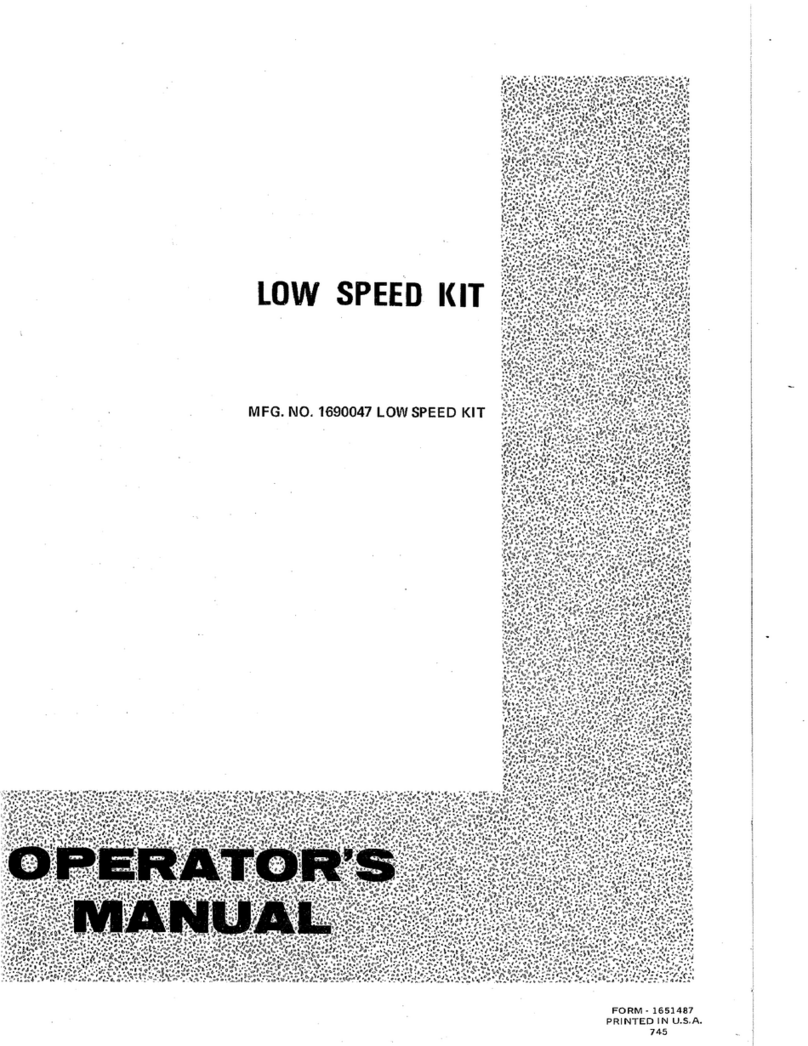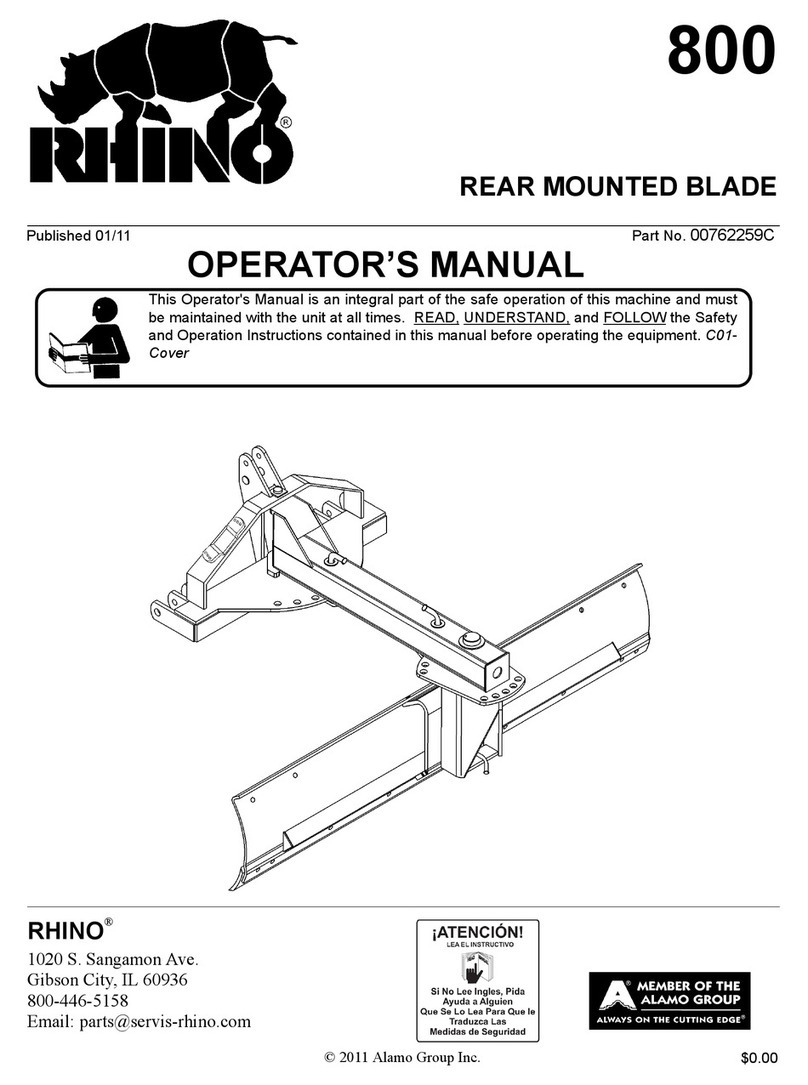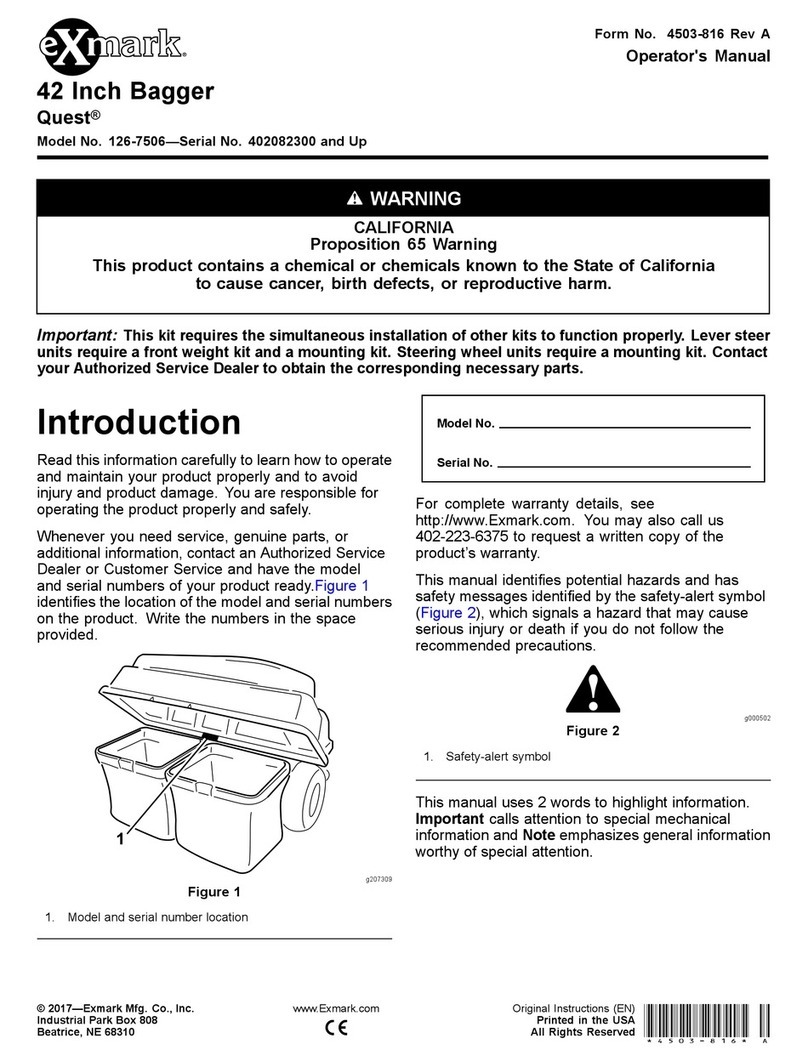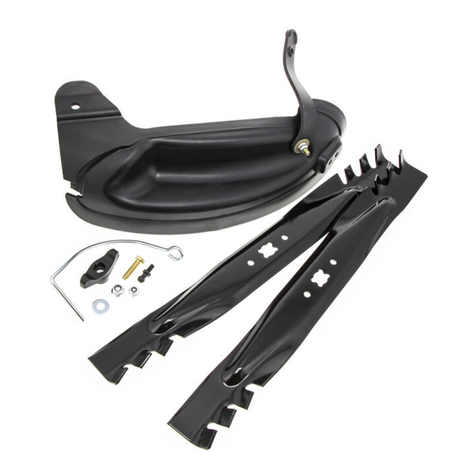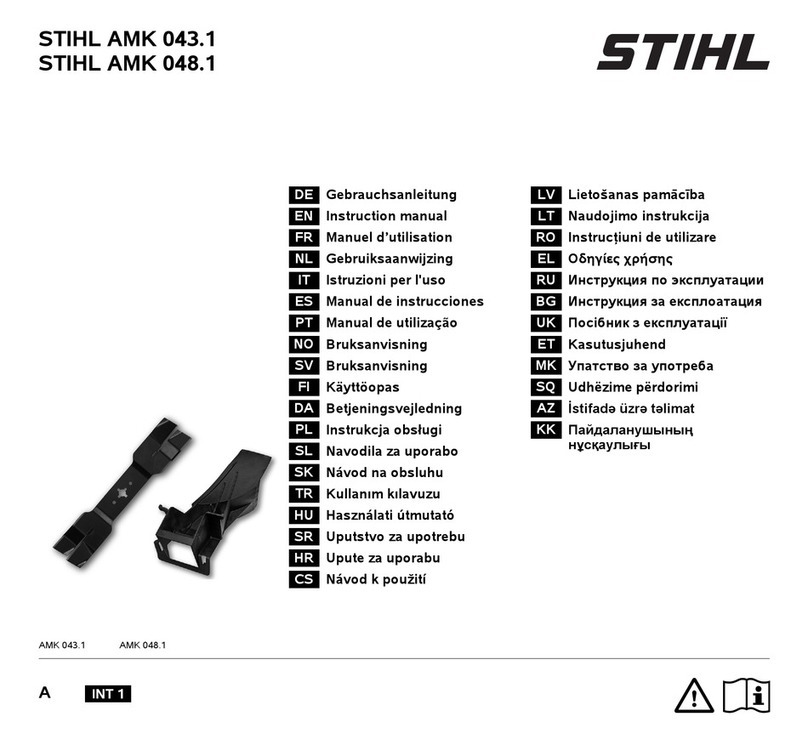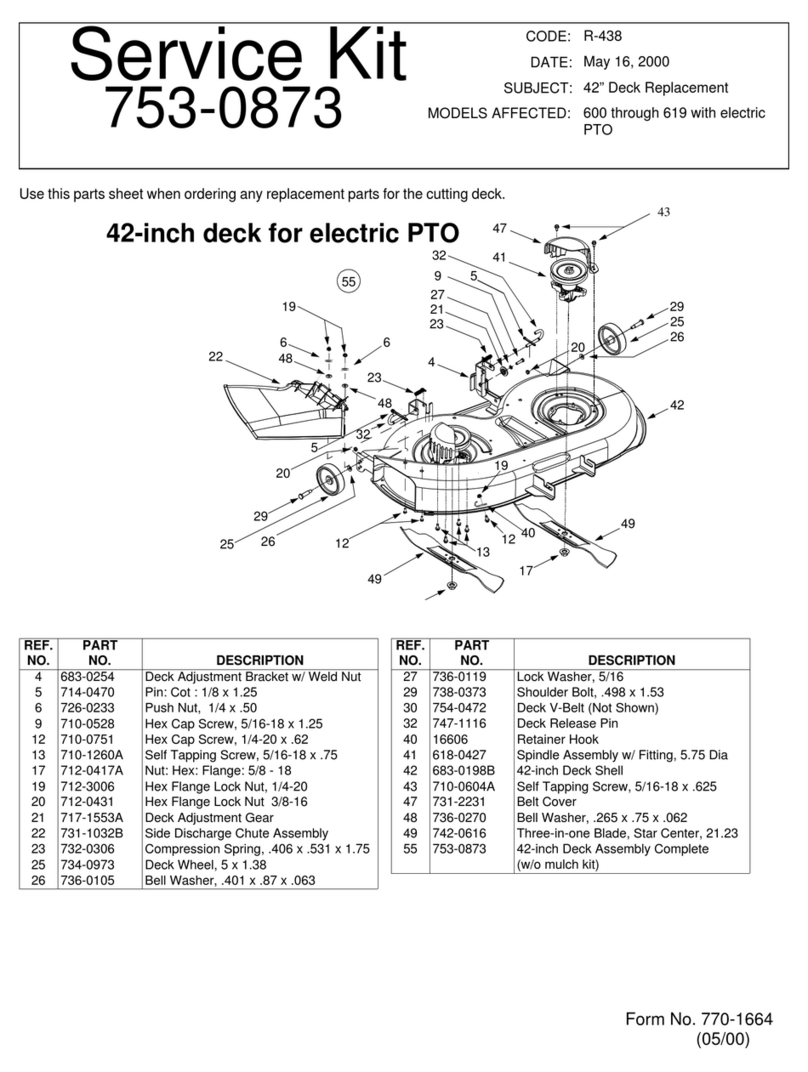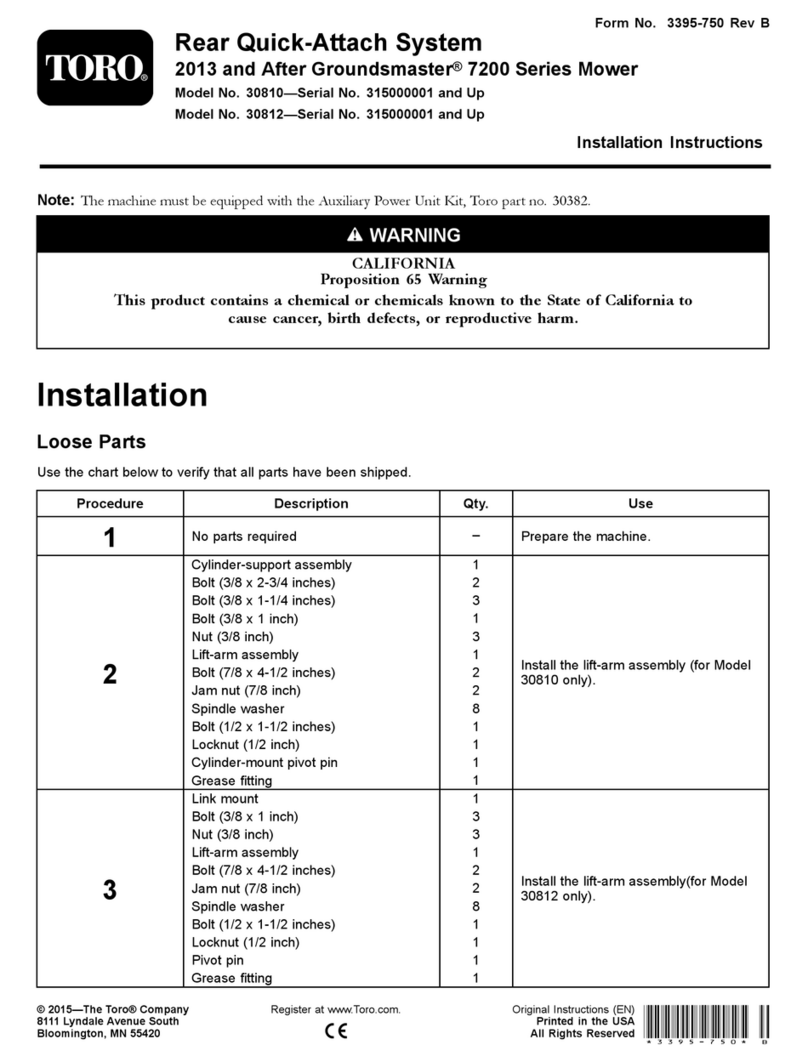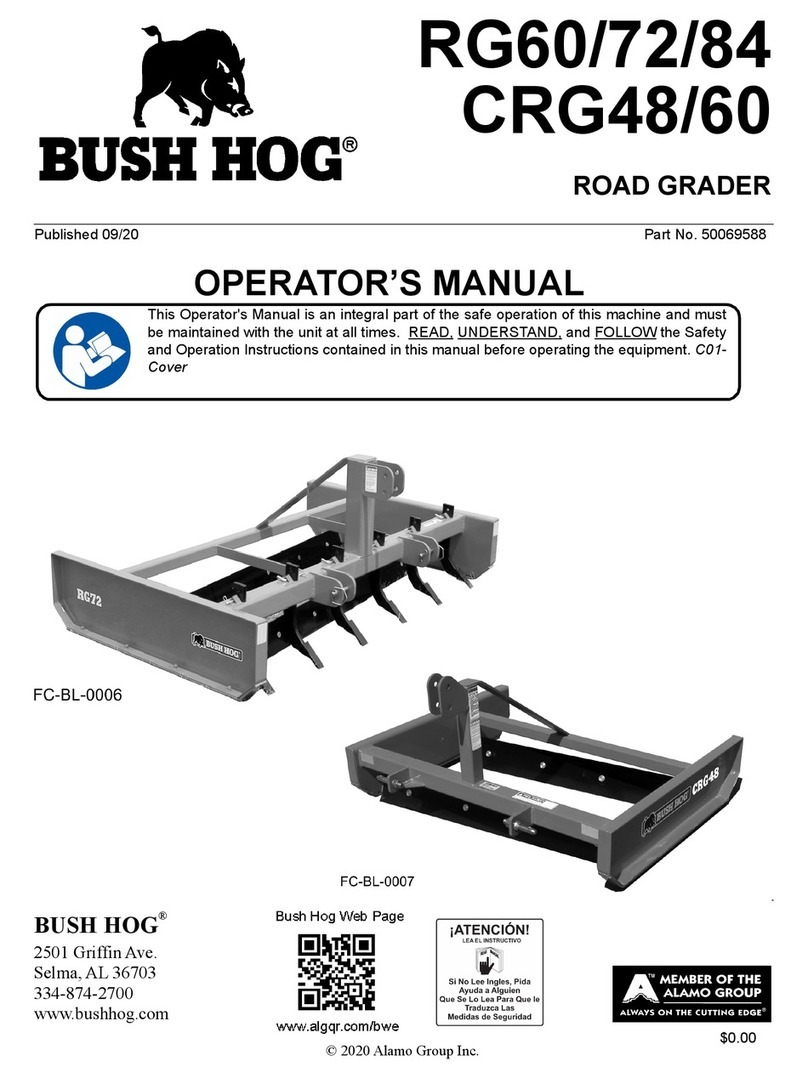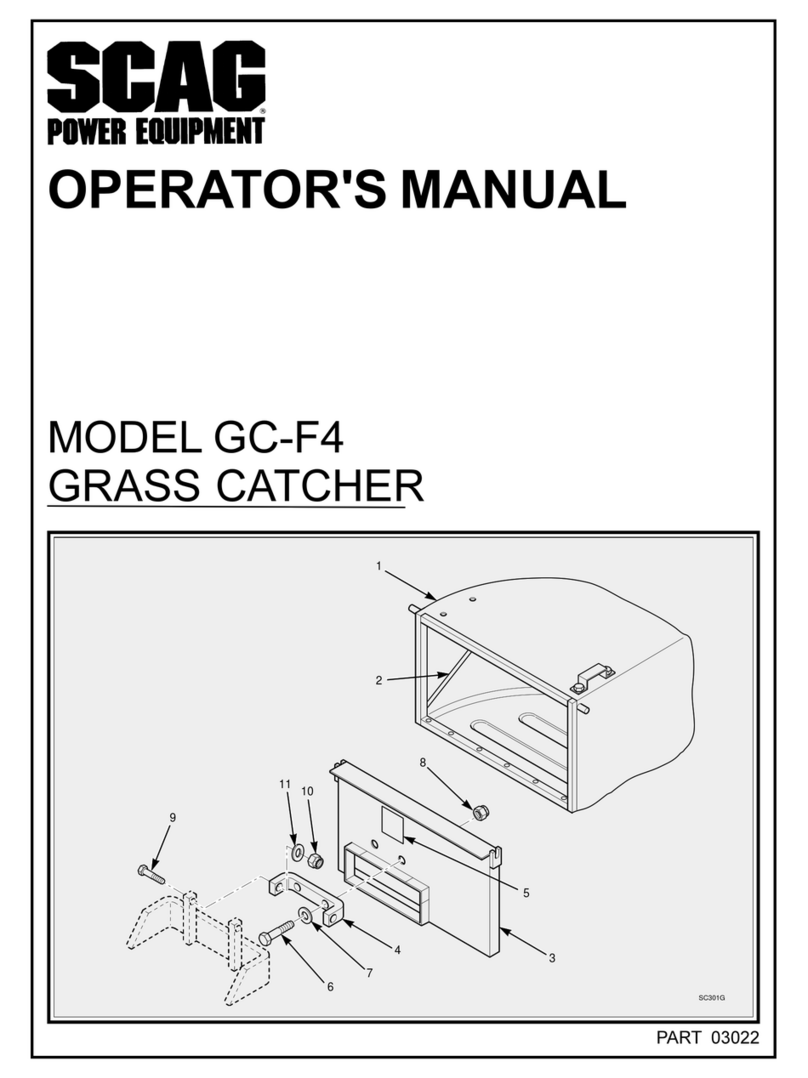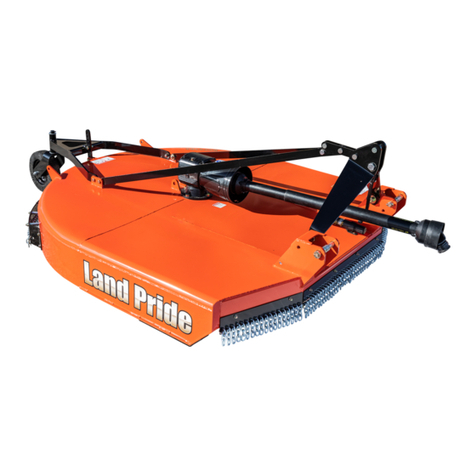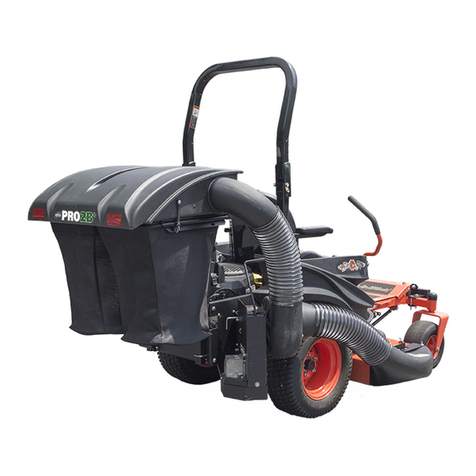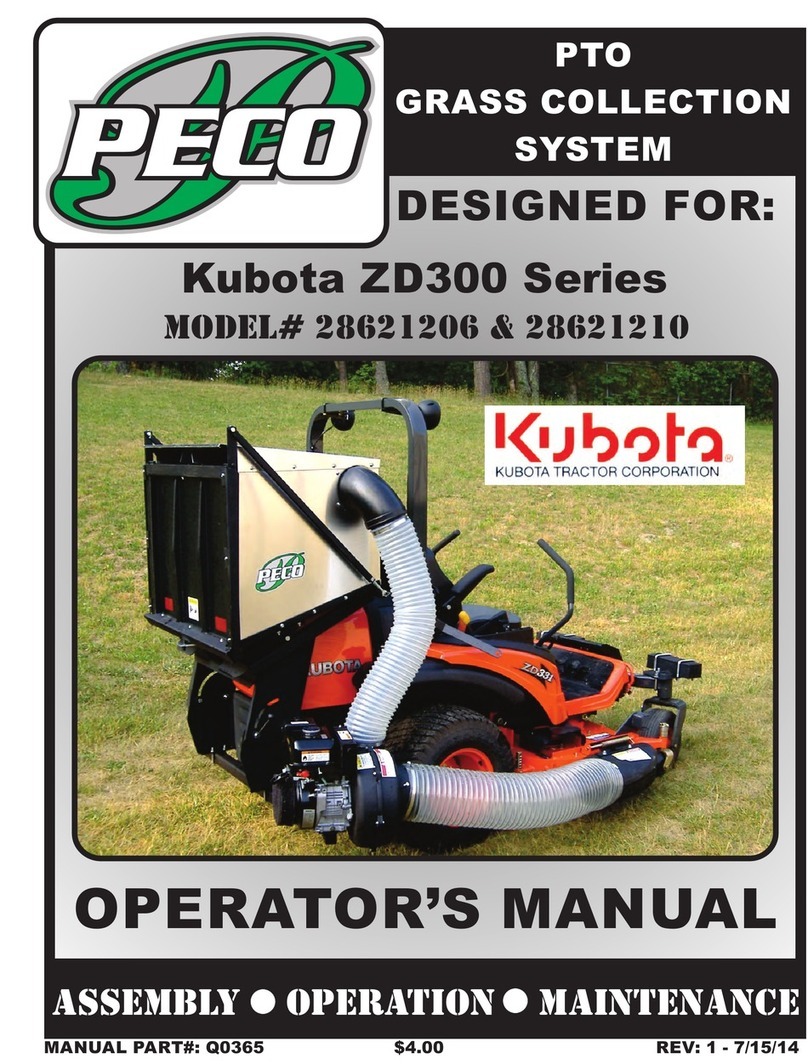Country Clipper CBS2 User manual

OPERATOR’S MANUAL
ASSEMBLY OPERATION MAINTENANCE
PART# 629GZ-001A
MANUAL#: Q0469 v5.0 - 6/12/2018
PROFESSIONAL BAGGING SYSTEM
Designed To Fit Charger & Challenger Series Mowers
MODEL# CBS2 (49131501)

2
PROFESSIONAL BAGGING SYSTEM
TABLE OF CONTENTS
Safety - - - - - - - - - - - - - - - - - - - - - - - - - - - - - - 2
Safety Alert Symbols- - - - - - - - - - - - - - - - - - - - - - 3
Warranty - - - - - - - - - - - - - - - - - - - - - - - - - - - - - 4
1-2 Description - - - - - - - - - - - - - - - - - - - - - - - - - 5
II INSTALLATION FOR USE - - - - - - - - - - - - - - - - - - - - - 5
2-1 Preparation Of Mower - - - - - - - - - - - - - - - - - - 5
SECTION PAGE
1-1 Introduction - - - - - - - - - - - - - - - - - - - - - - - - - 5
2-2 Right Frame Mount Plate and
I INTRODUCTION AND DESCRIPTION - - - - - - - - - - - - 5
2-9 Blower Cone Installation - - - - - - - - - - - - - - - - - 10
2-11 Upper Frame Assembly Installation - - - - - - - - - 12
2-4 PTO Mount Plate Assembly Installation
2-3 Rear Mount Support Bracket Installation - - - - - - 7
2-8 Cam Assembly Adjustment - - - - - - - - - - - - - - - 10
2-10 Lower Mount Tube Installation - - - - - - - - - - - - 11
2-6 PTO Handle Installation - - - - - - - - - - - - - - - - - 9
Rear Mount Plate Installation - - - - - - - - - - - - - - 6
2-12 Top Assembly To Upper Frame
Assembly Installation - - - - - - - - - - - - - - - - - - 12
2-5 PTO Assembly Installation - - - - - - - - - - - - - - - 9
2-7 Belt Installation/Removal and Adjustment- - - - - - 9
and Exhaust Diverter Installation - - - - - - - - - - - 8
2-13 Hinge Kit Assembly Installation- - - - - - - - - - - - 13
Exploded Part Views and Assemblies - - - - - - - - - 19-24
2-22 Installation and Removal Of Collection Bags - - - 18
3-2 Operation & Tips On Mowing - - - - - - - - - - - - - - 25
3-4 Unloading The Collection System - - - - - - - - - - - 25
2-20 Impeller Blade Removal/Installation- - - - - - - - - 16
SECTION PAGE
2-15 Boot To Mower Deck Installation - - - - - - - - - - - 14
2-17 Upper Hose Installation - - - - - - - - - - - - - - - - 15
2-18 Lower Hose To Blower Cone Installation- - - - - - 15
2-14 Boot Plate Installation- - - - - - - - - - - - - - - - - - 14
2-16 Length Of Hose Adjustment - - - - - - - - - - - - - - 15
2-19 Lower Hose To Boot Installation - - - - - - - - - - - 15
2-21 Weight Kit Installation- - - - - - - - - - - - - - - - - - -17
III OPERATING INSTRUCTIONS - - - - - - - - - - - - - - - - - - 25
3-1 General Safety - - - - - - - - - - - - - - - - - - - - - - - 25
3-3 Disengagement Of The PTO Assy. - - - - - - - - - - 25
Safety Decals - - - - - - - - - - - - - - - - - - - - - - - - - - 27
4-2 Lubrication- - - - - - - - - - - - - - - - - - - - - - - - - - 26
V PARTS AND SERVICE - - - - - - - - - - - - - - - - - - - - - - 26
Troubleshooting - - - - - - - - - - - - - - - - - - - - - - - - - - - 29
IV MAINTENANCE - - - - - - - - - - - - - - - - - - - - - - - - - - - 25
4-1 Maintenance Checklist - - - - - - - - - - - - - - - - - - 25
5-1 Parts And Service Information - - - - - - - - - - - - - 26
Torque Specifications - - - - - - - - - - - - - - - - - - - - - 28
SAFETY
you.
6. Do not attempt to operate your machine when not in the driver’s seat.
7. Always shut off blades and engine when emptying the container.
8. Stop machine, shut off deck attachment, set parking brake, shut off engine and remove ignition key before
removing clogs, removing or replacing hose, boot, blower cone, or performing any maintenance.
2. Know the controls and how to stop them quickly. READ THE OPERATOR’S MANUAL!
4. Be especially watchful of children and pets entering into the area while operating.
3. Do not allow children to operate the machine. Do not allow adults to operate it without proper instruction.
1. Read the operator’s manual carefully and familiarize yourself with the proper use of your attachment. Do not allow
anyone who is not acquainted with the Safety Instructions to use your attachment.
5. Keep your eyes and mind on your machine while mowing or operating your attachment. Don’t let others distract
9. Mow across the face of slopes (not more than 10 degrees); never up and down the face.
10. It is recommended that the container be emptied when half full while operating on slopes. Start mowing on slopes
12. Wear hearing protection.
13. Wear eye protection to prevent debris from getting into your eyes.
foreign object.
11. Inspect your lawn and remove any foreign objects before mowing. Never deliberately run the mower across any
when the container is empty.
2017 (v1.0)

3
WARNING! To avoid serious injury, perform maintenance on the vacuum collector; ONLY AFTER
STOPPING THE MOWER’S ENGINE AND WAITING FOR ALL MOVING PARTS TO COME TO A
COMPLETE STOP. Set the parking brake. Always remove the ignition key before beginning maintenance.
ALERT! YOUR SAFETY IS INVOLVED!”
Should be followed by the operator to avoid accidents. When
WARNING! For your own personal safety, ALWAYS mow ACROSS the face of slopes and
NEVER UP and DOWN the face. NEVER attempt to mow excessively steep slopes, and use
caution when turning on any slope.
SAFETY
WARNING! NEVER operate the mower unless the discharge guard and either the deflector assembly or
the vacuum collector adapter are fastened securely in place.
WARNING! Do not work around the mower deck boot or the blower area until you are certain that the mower
blades and the blower impeller have stopped rotating.
Safety Alert Symbol
This Safety Alert Symbol means: “ATTENTION! BECOME
This symbol is used to call attention to safety precautions that
you see this symbol, carefully read the message that follows
could result in death or serious bodily injury.
The signal words DANGER, WARNING, and CAUTION are used on the equipment safety signs. These words
are intended to alert the viewer to the existence and the degree of hazard seriousness.
and heed its advice. Failure to comply with safety precautions
Safety Signs
DANGER
!
CAUTION
This signal word indicates a potentially hazardous situation which, if not
avoided, will result in death or serious injury.
This signal word indicates a potentially hazardous situation which, if not
avoided, could result in death or serious injury.
It may also be used to alert against unsafe practices.
It may also be used to alert against unsafe practices.
This signal word indicates a potentially hazardous situation which, if not
avoided, will result in minor or moderate injury.
White letters on RED
Black letters on ORANGE
Black letters on YELLOW
WARNING
!
!
!
2017 (v1.0)

42017 (v1.0)
PECO LIMITED WARRANTY FOR NEW PRODUCTS
E. ACCIDENTS AND NORMAL MAINTENANCE
Engines and batteries attached to PECO products are covered under a separate warranty by the respective
manufacturer.
C. ITEMS NOT COVERED BY PECO WARRANTY
2. PARTS REPLACED DURING WARRANTY: Any new PECO part which is furnished in performance of
this warranty and is defective in material or workmanship as delivered to the purchaser will be repaired or
replaced, before the expiration of the original warranty period, whichever is later.
A. WHAT IS UNDER WARRANTY?
The warranty covers only defective material and workmanship. It does not cover depreciation or damage
caused by normal wear, accident, improper use or abuse of products. The cost of normal maintenance and
normal replacement of service items such as belts, cutting blades, hoses, etc., which are not defective shall be
paid for by the purchaser.
1. NO SERVICE CENTER WARRANTY
The only remedies the purchaser has in connection with the breach or performance of any warranty on New
PECO, Inc. consumer products are set forth above. In no event will PECO be liable for special incidental or
consequential damages.
H. REMEDIED EXCLUSIVE
The selling Service Center makes no warranty on his own on any item warranted by New PECO, Inc. unless he
delivers to purchaser a separate written warranty certificate specifically warranting the item. The dealer has no
authority to make any representation or promise on behalf of PECO or to modify the terms of this warranty in
any way.
from the date of delivery of the product to the original purchaser when used for in commercial applications.
Products designated as 'Residential' are warrantied for 90 days from the date of delivery of the product to the
original purchaser when in commercial applications.
Call PECO for Return Authorization. Damaged or broken parts other than engines or batteries, must be
returned to New PECO, Inc. at 10 Walden Drive, Arden, NC 28704 before any warranty adjustment can be
authorized. At the time of requesting warranty adjustment, the purchaser must present evidence of the date of
delivery of the product. The purchaser shall pay any charge for the product to and from Arden, NC.
D. UNAPPROVED ALTERATION OR MODIFICATION
B. SECURING WARRANTY ADJUSTMENTS
Neither New PECO, Inc. nor any company affiliated with it makes any warranties, representations or promises
as to the quality of performance of its products other than those set forth herein. Except as described above,
New PECO, Inc. makes no other warranties AND SPECIFICALLY DISCLAIMS ANY AND ALL IMPLIED
WARRANTIES OF FITNESS AND MERCHANTABILITY.
All obligations of New PECO, Inc. under this warranty shall be terminated if products are altered or modified in
ways not approved by New PECO, Inc.
3. COMMERCIAL USE: Products put to personal use around a single household or residence is considered
'Residential'; Products put to any business use (agricultural, commercial, or industrial) or used at multiple
locations is considered 'Commercial.' Products designated as 'Commercial' are warrantied for 12 months
PECO extends the following warranties to the original purchaser of each new PECO consumer product subject
to the following limitations.
F. NO REPRESENTATIONS ADDITIONAL WARRANTIES, DISCLAIMER
1. PRODUCT WARRANTY: Any part of any consumer product, which is defective in material or
workmanship as delivered to the purchaser will be repaired or replaced, as PECO elects, without charge for
parts or labor, if the defect appears within 12 months from the date of delivery of the product to the original
purchaser. ALL DEFECTIVE PARTS MUST BE RETURNED TO PECO FOR INSPECTION TO DETERMINE
VALIDITY OF WARRANTY CLAIMS. Freight and mailing will be borne by the customer.
G. PRODUCTS USED FOR RENTAL OR LEASE PURPOSES ARE WARRANTIED FOR 45 DAYS
FROM DATE OF ORIGINAL SALE ONLY

5
Your grass collection system has been designed to give
you a low maintenance, simple, and effective way to
collect the grass clippings from your mower. This manual
is provided to give you the necessary instructions to
properly mount and operate the collection system on
your mower. Please read this manual thoroughly.
Understand what each control is for and how to use it.
Observe all safety decal precautions on the machine and
noted throughout the manual.
NOTE: all references made to right, left, front, rear, top
or bottom are as viewed from the normal operator’s
position on the mower.
1-2 Description
1-1 Introduction
The grass collection system is designed for turf
maintenance where there is a need to collect the grass
clippings as the mower cuts the turf. It is also used for
picking up leaves and twigs in pre-season and post-
season clean-up.The blower, mounted on the right side
of the unit, uses a belt and gearbox system from the
engine PTO shaft. Drive train protection comes through
belt slippage. The blower draws grass clippings from the
discharge area of the cutter deck back to the (3) - 4.0
cubic foot collection bags P#(G0003) at the rear portion
of the mower frame. The operator can engage the blower
with a push of the over-center linkage on the right side of
the unit. Once the bags are full with clippings, they can
be released to make for easy dumping.
Section II - Installation For Use
Remove deck drive belt from the clutch pulley (refer to
your Country Clipper operator’s manual). From the
underside of the engine, disconnect the wiring harness
attached to the electric clutch. Remove the bolt and
electric clutch from the mower. Next, remove the D-drive
spacer using an arbor press or equivalent. On removal,
adjacent bearing OUTER race must be supported or
bearing damage may occur. Refer to Figure 2-1a.
2-1 Preparation Of Mower
SECTION I - INTRODUCTION AND DESCRIPTION
Once the Engine Pulley Bushing P#(S0191) is installed,
reattach the clutch assembly to the mower and then
review Figure 2-1c. To assemble and fasten the Engine
Pulley, align Pulley hole to the Engine Pulley Bushing
and fasten using (1) Clamp Washer P#(K0278), (1)
7/16” lock washer P#(K0140), and 7/16”-20 x 3-1/2” hex
bolt P#(K0550). Torque the bolt to 55 ft./lbs. The added
pulley will power the collection system and should
resemble Figure 2-1d when installed.
The engine pulley bushing must be installed using an
arbor press or equivalent. Upon Installation, opposite
bearing inner race must be supported or bearing
damage may occur. Refer to Figure 2-1b.
PRESS
Figure 2-1a
PRESS
Figure 2-1b
Engine Pulley Bushing Installation
Electric Clutch
Figure 2-1d
Engine Pulley
Bushing
Hex Bolt
Lock Washer
Pulley
Bushing
Number
Located
Here
Figure 2-1c
Use M0266 (4.25” OD) For Charger Mowers
Use M0309 (4.75” OD) For Challenger Mowers
Clamp Washer
Pulley
Engine Pulley Assembled Into Electric Clutch

6
Kohler Command 27HP
Kohler Command 27HP
Kawasaki FX801V,
FS730V & B&S 30HP
Kawasaki FX801V,
FS730V & B&S 30HP
Kawasaki FX801V,
FS730V & B&S 30HP
Kohler Command 27HP Kawasaki FX801V,
FS730V & B&S 30HP
Kohler Command 27HP
Kawasaki FX801V,
FS730V & B&S 30HP
Kohler Command 27HP
Kohler Command 27HP
Kawasaki FX801V,
FS730V & B&S 30HP
NOTE: The 2013 Charger Series will
require an after-market auxiliary
cooling kit. Contact your Country
Clipper dealer for purchasing
information for this auxiliary cooling
kit (Part Number 629GE-001A).
hole locations specific to your
Use Figure 2-2b for mounting
engine model.
2-2 Right Frame Mount Bracket and
Rear Mount Plate Installation
Remove rear engine guard and hardware. Secure the
right frame bracket P#(B0810) to the rear frame of the
mower using (1) 1/2”-13 x 2” P#(K1234) HHCS, (1)
1/2”-13 x 1” HHCS P#(K1231) and (2) 1/2”-13 nylon
flange locknut P#(K2012). Secure the rear mount plate
to the right frame bracket and rear frame of the mower
using (4) 3/8”-16 x 1” HHCS and P#(K1191) and (4)
3/8”-16 nylon flange locknuts P#(K2038). Refer to
Figure 2-2a.
(4) 3/8”-16 x 1”
Hex Bolts
(4) 3/8”-16 Locknuts
Right Frame
Bracket
(1) 1/2”-13 x 2”
(1) 1/2”-13 Locknut
Figure 2-2a
(1) 1/2”-13 x 1”
(1) 1/2”-13 Locknut
Figure 2-2b

7
Secure the rear mount support bracket P#(B0816) to the
rear mount plate and bumper guard, using the (2)
existing 1/2” -13 hex bolts and nuts and (2) 3/8”-16 x 1”
HHCS P#(K1191) and (2) 3/8”-16 locknuts P#(K2038).
The rear mount support bracket should be installed to
the inside of the bumper guard and rear frame bracket.
Refer to Figure 2-3a and 2-3b.
2-3 Rear Mount Support Bracket
Installation
Figure 2-3a
Rear Mount
Support Bracket
Existing
Hardware
Rear Mount
Plate
Existing
Hardware
Bumper
Guard
Rear Mount Support
Bracket Mounts to
Inside of Rear Mount Plate
and Bumper Guard
Figure 2-3b
(2) 3/8”-16 x 1”
HHCS
(2) 3/8”-16
Locknuts

8
2-4 PTO Mount Plate Assembly
Installation and Exhaust Diverter
Installation
Secure the left PTO mount plate P#(B0813) to the right
frame bracket using (1) 3/8”-16 x 1” HHCS P#(K1191),
(1) 3/8” flat washer P#(K0047) and (1) 3/8”-16 nylon
flange locknut P#(K2038). Secure the bottom section of
the mount plate to the right frame bracket using (1) 1/2”-
13 x 2” HHCS and P#(K1234) and (1) 1/2”-13 nylon
flange locknut P#(K2012). Refer to Figure 2-4a for
reference. Leave the hardware finger tight until the PTO
stop plate has been installed.
For engine models that divert exhaust to the right side,
attach the exhaust diverter P#(J0292) to the muffler as
shown in Figure 2-4b. Fasten the deflector using the
exhaust clamp P#(X1064). Angle the diverter so that the
exhaust does not burn the cloth bags.
Secure the right PTO mount plate P#(B0814) to the
right frame bracket using (1) 3/8”-16 x 1” HHCS
P#(K1191), (1) 3/8” flat washer P#(K0047) and (1) 3/8”-
16 nylon flange locknut P#(K2038). Secure the bottom
section of the mount plate to the right frame bracket
using (1) 1/2”-13 x 1-1/2” HHCS P#(K1233) and 1/2”-13
locknut P#(K2012). Refer to Figure 2-4 for reference.
Leave the hardware finger tight until the PTO stop plate
has been installed. Secure the PTO stop plate
P#(B0733) to the left and right PTO mount plates using
(4) 1/4”-20 x 3/4” HHCS P#(K1222) and (4) 1/4”-20
nylon flange locknuts P#(K2014). Tighten all hardware
at this time. Refer to Figure 2-4a.
Left PTO
Mount Plate
(1) 3/8”-16 x 1” HHCS
(1) 3/8” Flat Washer
(1) 3/8”-16 Locknut
Right PTO
Mount Plate
(4) 1/4”-20 x 3/4” HHCS
(4) 1/4”-20 Locknuts
PTO Stop
Plate
(1) 1/2”-13 x 2” HHCS
(1) 1/2”-13 Locknut
Figure 2-4a
(1) 3/8”-16 x 1” HHCS
(1) 3/8” Flat Washer
(1) 3/8”-16 Locknut
(1) 1/2”-13 x 1-1/2” HHCS
(1) 1/2”-13 Locknut
Figure 2-4b Exhaust Clamp
Attach Diverter

9
To mount the PTO assembly, insert the pivot rod on the
PTO assembly P#(A1623) into the mounting slots
located on the left & right PTO mount plates. Tilt the
PTO assembly upward and insert the PTO mount pin
P#(B0274) through the hole in the top of the right PTO
mount plate assembly. Secure the PTO mount pin using
1/8” x 2-3/8” hair pin clip P#(K0086) as shown in Figure
2-5.
Mount the PTO handle assembly P#(A1142) to the
universal PTO P#(A1623) using (3) 1/4”-20 x 3/4” HHCS
P#(K1222) and (3) 1/4”-20 nyloc nuts P#(K1128).
Before fastening, make sure that there is room for the
handle to engage and disengage without the handle
hitting the mower’s fuel tank. Attach the handle grip
P#(J0522) to the PTO handle assembly. See Figure 2-6
for reference.
2-5 Universal PTO Installation
2-6 PTO Handle Assembly Installation
Remove the belt guard. Loosen the (4) bolts P#(K1191),
(2) on each side, that secure the gear box assembly to
the PTO assembly P#(A1623) (Figure 2-7a and 2-7b).
Loosen the adjustment bolt P#(K0348) until the gear
box assembly is at its far left adjustment (the gear box is
moved toward the mower’s engine pulley). Connect the
kevlar cord belt (A54K P#(M0255) for Charger Mowers)
or (A55K P#(M0248) for Challenger Mowers) from the
engine pulley to the lower gear box pulley (Figure 2-7c).
To tension the drive belt, turn the adjustment bolt
clockwise until there is 1” of deflection, with 10-11 lbs.
of pressure, at the center of the belt between the engine
pulley and the gear box pulley. Once the correct tension
of the belt is achieved, tighten the (4) bolts that secure
the gear box assembly. Replace the belt guard.
2-7 Belt Installation
PTO Mount
Pin
Hair Pin
Clip
Pivot
Rod
Figure 2-5
Figure 2-6
(3) 1/4”-20 x 3/4” HHCS
(3) 1/4”-20 Nyloc Nut
PTO Handle
Assembly
Loosen
Bolts
Loosen
Bolts
Gear Box
Assembly
Belt
Guard
Adjustment
Bolt
Engine
Pulley
Gear Box
Pulley
Figure 2-7a
Figure 2-7b
Figure 2-7c

10
2-8 Cam Assembly Adjustment
The cam assembly P#(A0422), which controls the blower belt tension, comes from the factory pre-adjusted. If the belt
is too tight or becomes too loose, remove the hair pin clip P#(K0130) from the belt tension rod P#(K0326) and pull the
“L” end of the rod out of it’s hole in the cam assembly. The tension rod may then be screwed out to tighten the belt or
screwed in to loosen the belt. Replace the “L” end into the top hole in the cam and replace the hair pin clip. Adjust the
cam stop bolt P#(K1159) to allow the cam to rotate slightly over center when the blower is engaged (Figure 2-8).
Thread (1) 5/16”-18 jam nut P#(K0120) onto each end of (2) 5/16”-18 x 2-1/2” HHCS P#(K0125). Now partially thread
the bolts into each of the two tabs located on the blower housing. Place blower cone so the two tabs line up with the
bolts then tighten completely. Refer to Figure 2-9 for reference.
2-9 Blower Cone Installation
Figure 2-8
Cam
Assembly
Cam Stop
Bolt
Tension
Rod
Figure 2-9
(2) 5/16”-18 x 2-1/2”
All Thread HHCS Blower
Housing Tab
(2) 5/16”
Jam Nut
Blower
Housing
Blower
Cone Tab

11
Secure the lower mount tubes P#(B0752) to the rear
mount bracket using (2) 5/16”-18 x 2-1/4” u-bolts
P#(K1098) and (4) 5/16”-18 nylon flange locknuts
P#(K2516) PER TUBE. The bottom edge of the lower
mount tubes should be flush with the top edge of the
bumper guard before the hardware is tightened. Refer to
Figure 2-10.
2-10 Lower Mount Tube Installation
Figure 2-10
(2) 5/16”-18 U-Bolts
(4) 5/16”-18 Locknuts
PER Tube
Lower Mount
Tubes

12
2-11 Upper Frame Assembly
Installation
NOTE: During this step, it is suggested that two people
install the upper frame to the lower mount tube.
Lift the upper frame assembly P#(A1058) above the
lower mount assembly and lower the top assembly onto
the two vertical tubes. Secure the top assembly to the
lower mount assembly using (2) clevis pins P#(K0133)
and (2) hair pin clips P#(K0088). Refer to Figure 2-11.
2-12 Top Assembly To Upper Frame
Assembly Installation
Position the top assembly P#(A1190) above the upper
frame assembly as shown in Figure 2-11. Fasten the top
assembly to the upper frame assembly using (2) 5/16”-
18 x 2-1/2” HHCS P#(K0125) and (2) 5/16”-18 nylon
flange locknuts P#(K2516). Leave the locknuts slightly
loose, to allow the top assembly to open and close
easily.
Figure 2-11
Top Assembly
Upper Frame
Assembly
(1) 5/16-18 x 2-1/2” HHCS
(1) 5/16”-18 Nylon Flange
Locknut
Hair Pin
Clip
Clevis Pin

13
2-13 Hinge Kit Assembly Installation
Assemble the hinge kit as shown in Figure 2-13, using
(2) 5/16”-18 x 1” HHCS P#(K1154), (3) 5/16”-18 nylon
flange locknuts P#(K2516), (5) 1/4” flat washers
P#(K0037) and (2) swing arm brackets P#(ZT-0004).
Place (1) vinyl cap P#(J0289) on the end of the hex bolts
as shown in Figure 2-13. Leave the nuts loose enough to
allow fluid movement of the top when opening and
closing. When opened, the top should rest on the middle
joint of the hinge allowing it to remain up.
ZT-0004
K2516
K0037
K1154
J0289
Figure 2-11

14
Secure the boot plate P#(B0820) to the aluminum boot
P#(E1902) using (2) 3/8”-16 x 1” carriage bolts
P#(K1182) and (2) 3/8”-16 nylon flange locknuts
P#(K2038). Insert the carriage bolts from the inside of
the boot so the threads are on the top of the boot. This
will prevent grass clippings from collecting on the
threads. Leave the hardware loose until the boot plate
has been attached to the mower deck.
Refer to Figure 2-14a and 2-14b for Challenger Mowers
or 2-14c for Charger Mowers.
2-14 Boot Plate Installation 2-15 Boot To Mower Deck Installation
Remove the hardware from the grass deflector and
insert (1) boot rod P#(B4331) into the grass deflector
mounting holes as shown in Figure 2-14a. Secure the
boot rod using (1) hair pin clip P#(K0099). With the
carriage bolts from Section 2-14 still loose, adjust the
position of the boot so that there is no gap between the
mower deck and the boot. Tighten the hardware at this
time.
Boot Rod
(2) 3/8”-16 x 1”
Carriage Bolts
(2) 3/8”-16
Locknuts
Boot Plate
Aluminum
Boot
Hair Pin
Clip
Figure 2-14a
Figure 2-14c
Charger
Mounting Holes
Figure 2-14b
Challenger
Mounting Holes

15
Installation
2-18 Lower Hose To Blower Cone
Slide a hose clamp P#(J0080) over both ends of
the lower hose. Then proceed to slide the lower hose
onto the blower cone. Tighten the hose clamp. Refer to
Figure 2-19.
Take the unattached end of the lower hose and slide it
clamp to secure the hose to the boot (Figure 2-19). Tip:
Before securing clamp rotate hose counter-clockwise
boot to mower deck.
(away from yourself) approximately 1” to aid in retaining
2-19 Lower Hose To Boot Installation
over the circular end of the boot. Use the lower hose
(Figure 2-19) for details. Make sure both ends of the
assembly inlet. Tighten the hose clamps.
blower assembly, and the deck boot.
adjust for the blower assembly’s movement as well as
hoses until you have tried to fit them on your machine.
allow for enough clamping surface between the inlet,
end of the 6” hose onto the inlet. Make sure there is
Slide a pre-assembled hose clamp P#(J0060) onto both
2-16 Length Of Hose Adjustment
2-17 Upper Hose Installation
about a two-inch overlap between the hose end and the
the inside of the top to the outside and lock into place.
The hoses in steps 2-17 and 2-18 must be cut to fit your
Remember that the hoses have to be long enough to
ends of the 6” upper hose (Figure 2-19). Then slide one
container inlet. Proceed to slide the opposite end of the
6” hose onto the outlet of the blower assembly. See
Fasten the inlet to the plastic top by sliding the inlet from
machine. Follow steps 2-17 and 2-18. Do not cut the
hose are clearly attached to the inlet and the blower
Figure 2-19
Inlet
Hose
Clamps
Hose
Clamps
Boot
Lower
Hose
Blower
Outlet
Upper
Hose
Blower
Cone

16
3
2
4
5
1
3
5
6
7
8
9
10
12
13
11
14
9Taper-Lock Bushing
Enlarged View
1 - Try carefully hitting the base of the impeller blade
(#1), between each vein (#12), with a rubber mallet to
loosen the taper-lock bushing hold.
To Replace: First, place the impeller blade (#1) over the
drive shaft (#13). Next, slide the taper-lock bushing (#9)
on to the drive shaft and into the impeller blade, aligning
the non-threaded holes (#14) of the taper-lock bushing
to the threaded holes of the impeller blade. Then, fasten
by using two 1/4”-20 x 1” HHCS (#10), one spacer
bushing (#8) one taper lock bushing washer (#7), and
one 3/8”-16 x 1-1/2” HHCS (#6). Torque all bolts to the
specifications located in the chart towards the back of
this manual. Last, rotate the impeller blade to ensure
that the blade is clear of contact on all sides of the
blower housing.
Tips on removing impeller blade;
2 - Spray break-free lubricant into the surrounding areas
of the taper-lock bushing (#9) and repeat Tip 1.
2-20 Impeller Blade
Removal/Replacement
To gain impeller blade (#1) access, first remove the
blower cone (#2) from the blower housing, located on
the PTO assembly P#(A1821), by removing two blower
cone bolts and nuts (#3). Next, remove the blower
housing front (#4) by removing seven bolts and nuts (#5)
around the outer housing edge. Refer to Figure 2-20.
To Remove: First, remove one 3/8”-16 x 1-1/2” HHCS
P#(K1211) (#6), one taper-lock bushing washer
P#(K0278) (#7) and one spacer bushing P#(S3242) (#8)
from the taper-lock bushing (#9). See Figure 2-20. Next,
remove two 1/4”-20 x 1” HHCS (#10) and place them
into the threaded holes (#11) of the taper-lock bushing
P#(S4302). Last, gradually thread each bolt evenly into
the taper-lock bushing, forcing the blade to break-away
from the taper-lock bushing.
Figure 2-20

17
Weight Kit Installation
Review Figure A. Position the Dual Weight Bracket Base (Item#1) under the right caster tubing w/ opening towards
caster fork. Next, position the Weight Bracket Clamp (Item#2) on top of caster tubing w/ opening towards caster fork.
Align the (4) holes of the Weight Bracket Clamp (Item#2) to the holes in the Dual Weight Bracket Base (Item#1).
Loosely fasten the Weight Bracket Clamp (Item#2) to the Weight Bracket Base (Item#1) using (4) 5/16"-18 x 3" Bolts
(Item#4) & (4) 5/16"-18 Ny-Flange Lock Nuts (Item#5).
Position the Weight Bracket Base and the Weight Bracket Clamp assembly along the caster tubing to prevent
interference from caster forks or any other objects. Tighten the fasteners in an 'X’ pattern until assembly is firmly
clamped to caster tubing. Do not over tighten which may result in bending Weight Bracket Clamps (Item#3).
Insert (1) Weight (Item#3) Into the Weight Bracket Base (Item#2) & align the holes of the Weight w/ the holes of the
Weight Bracket Base (Item#2). Fasten the Weight (Item#1) to the Weight Bracket Base Using (1) Clevis Pin (Item#6)
& (1) Hair Pin Clip (Item#7) per weight.
Repeat on right caster with Quad Weight Kit, Figure B
1
2
5
3
4
6
7
Figure A
Item # Part # Desc. Qty.
1 B1014 Dual Weight Bracket / Base 1
2 B1015 Weight Bracket / Clamp 1
3 Y0025 28 lb. Suitcase Weight 2
4 K1472 HHCS 5/16"-18 x 3" GR5 4
5 K2516 Ny-Flange Lock Nut 5/16"-18 4
6 K1473 Clevis Pin 1/2" x 3" 2
7 K1478 Hair Pin Cotter / Double Loop 2
Figure B

18
To empty the bag, first unlatch and lift top, next remove
the bag and bag ring by sliding rearward, then grasp the
loop on the bottom of the bag, and last turn it upside
down to empty the collected debris (Figure 2-22d).
Repeat for the other bags. Reinstall all bags, line with
plastic bags if desired, close the plastic top and reattach
the draw latches.
Plastic lawn and leaf bags, 33 gallon size, may be used
inside the cloth bags. Be sure to leave enough plastic
bag hanging over the frame so the plastic bags can be
twist tied before emptying (Figure 2-22e).
2-22 Installation/Removal Of
Collection Bags
IMPORTANT!
To prevent bag wear, install (2) red plastic end caps
P#(J0274), as shown in Figure 2-22a, on each bag ring
before installing bags.
To install the bag onto the bag ring, place the seam
openings of the bag onto the bag ring openings and turn
the bag one full turn (360 ) so the plastic end caps are
located opposite to the opening in the bag (Figure 2-
22b). Do this for each of three bags.
Install the completed assemblies onto the support frame
and close the plastic top. Fasten both draw-latches to
hold the plastic top closed (Figure 2-22c).
Figure 2-22d
Figure 2-22e
Grasp Bag
Here
Plastic Bag
Cloth Bag
Figure 2-22a
Figure 2-22c
Figure 2-22b
Red Plastic
End Caps
Bag Ring
Bag
Bag Opening
Bag Ring End
Caps Opposite
of Bag Opening
Plastic Top
Fasten Draw
-Latch Here &
Opposite Side
For Proper Unit
Transportation
Completed Bag
Installed

19

20
2
9
4
6
7
10
3
5
8
11
18
17
14
16
15
1
13
12
Item # Doc # Title Qty
1 V0022 PRO 3 BAGGER TOP 1
2 B0676 Hinge Stop Pl. 1
3 K0114 BLACK PLASTIC RIVET 14
4 C0069 DUST GUARD BRACE 1
5 K1030 1/4"-20 x 1-1/4" CARRIAGE BOLT 2
6 J4009 SHORT RUBBER STRAP W/ S HOOK 2
7 K0037 1/4" FLAT WASHER .75 OD x .314 ID x .060 T 2
8 K1128 1/4"-20 NYLOC NUT 2
9 C0026 GRASS DEFLECTOR 1
10 K0062 3/16" x 1-1/2" FENDER WASHER, Z 4
11 K1265 BLACK PANEL RETAINER 3
12 V1120 Black Plastic Screen 1
13 V1118 DUST GUARD 1
14 R1057 2" x 4" Red Reflector Label 2
15 R1069 Warning - Turn Off Blower Label 1
16 R1065 Made In USA Label 1
17 R1054 Important Check Hoses 1
18 R1051 Warning - Use Hearing Protection 1
Exploded Parts View
A1190 Top Assembly
Table of contents
Other Country Clipper Lawn Mower Accessories manuals
